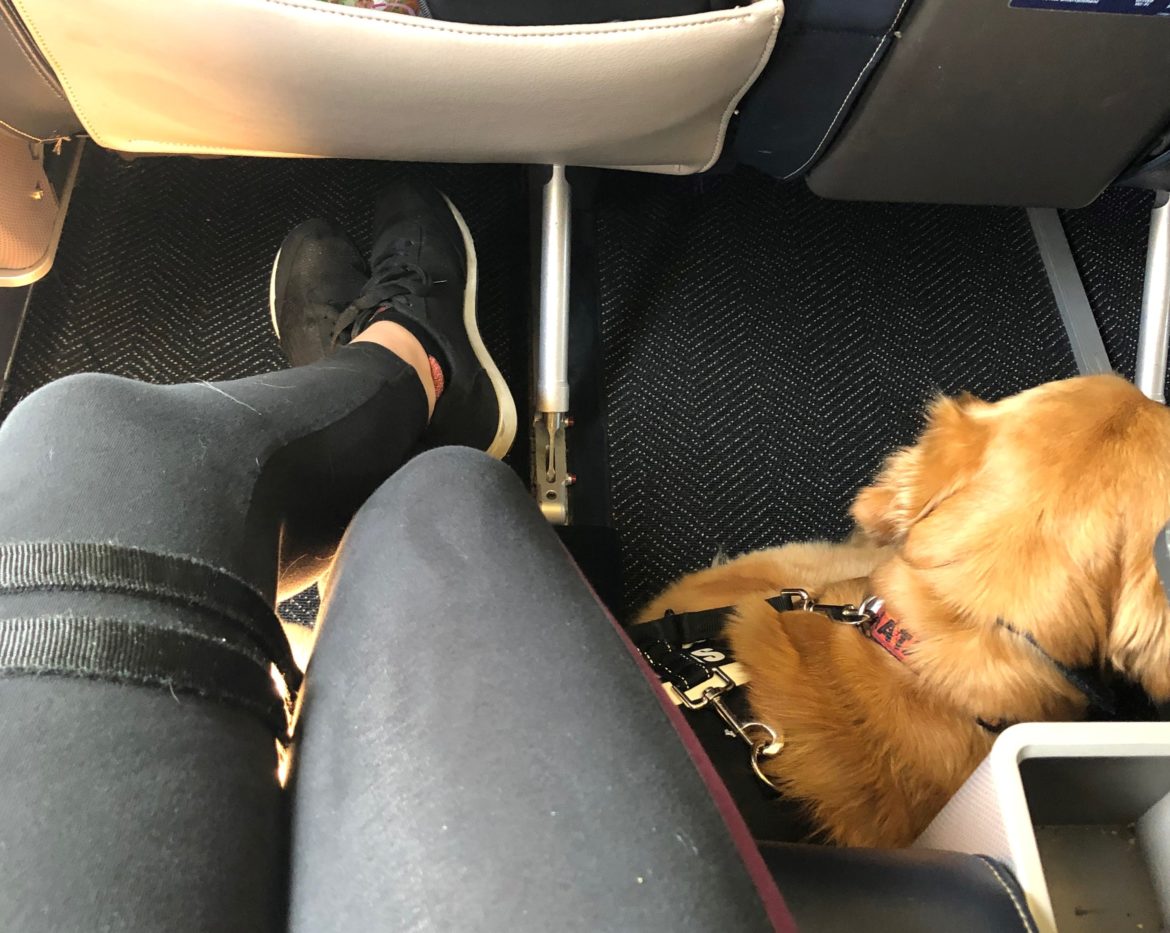A FAIRLY COMPREHENSIVE GUIDE TO AIR TRAVEL WITH AN ASSISTANCE DOG, FOCUSING ON THE TECHNICALITIES AND REQUIREMENTS
Please also see: Our blog post which covers what to take with you, and top tips on how to manage airports and prepare your dog for flying.
Sometimes you may want or need to travel to another country (or within the country) and plane is the best, quickest, easiest or cheapest method of transport. But you likely haven’t seen many dogs in the cabin of planes, especially in the UK, or on international flights; so can you take your assistance dog on a plane with you?
Is it Possible?
In short, yes. Is it easy? No, not really. It isn’t like getting on a bus or a train where you can just turn up and/or manage it with a simple phone-call. It involves forethought, research and advance planning to make sure you get everything done correctly as it is simply not worth making mistakes and ending up stuck somewhere abroad. You will likely also encounter a fair amount of confusion, misinformation and ignorance from many staff, particularly if you have an owner trained assistance dog.
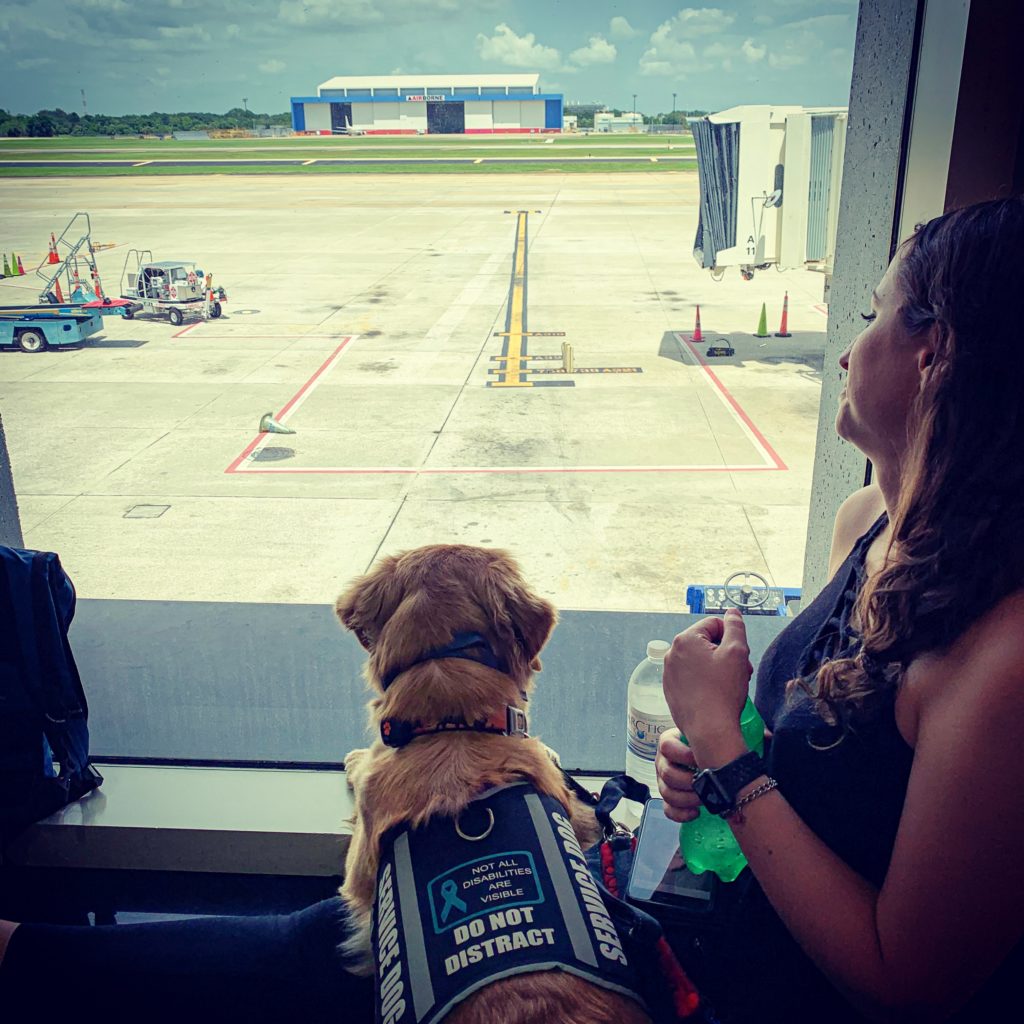
Our very own Dory Adelie frequently flies in and out of the UK (between the USA and the UK) so she has a lot of experience of travelling by plane and knows what is required in terms of health paperwork and training/airline requirements. There is a government webpage which is helpful, providing a lot of general information as well.
Disclaimer: this information is based on travelling with major airlines from/to major airports (namely London Heathrow/Gatwick). There may be variation when it comes to smaller airlines and other airports, and there are sometimes exceptions. Also, the guidelines for air travel when it comes to training etc. vary significantly between airlines and also change over time so this information is accurate at the time of writing (September 2019). Contact the airline if you are not sure.
Method
First off, you have a couple of options: cargo, cabin or if you are not sure it is necessary for your dog to be with you (and/or they are not ready to travel by plane) then to find alternative accommodation for them while you are away. The last option is more appropriate for “in training” dogs of a young age, but obviously not so much for those who have their Assistance Dog with them full-time and require their assistance while away or during travel. Cargo travel (your dog travelling in the underbelly of the plane, in the “hold” as a “checked pet”) is a valid option for many people, however it can be very expensive and does require you separating from your dog for the majority of your journey.
There is sometimes a fee for flying with your dog in the cabin, but the fee is actually for the landing and is put in place by the Animal Reception Centre, usually if you are not with an Assistance Dogs International (ADI) organisation [this includes Assistance Dogs UK (ADUK)]. It appears to be decided on a case by case basis, whether you are “approved” or not, but if it is charged it is usually approximately £350/$400.
The rest of this page is based on you requiring your dog to be with you during the journey and therefore them travelling in the cabin with you.
HEALTH/ENTRY REQUIREMENTS
Travelling abroad from the UK
As it stands, it isn’t too taxing to travel out of the UK to a lot of countries as they have significantly more lax entry requirements than the UK. It is definitely still worth researching in advance, finding out the specific country’s entry requirements. Many airlines request paperwork confirming valid rabies vaccination in order to travel at all, so this is definitely worth making sure you are up to date well in advance and printing out a copy of the certification. Frequently airline staff will request that you provide “DEFRA paperwork” in order to receive any accommodations from them or at check-in, but this is due to misinformation, simply go to the government website and send the link to them so they can see what is required and that you can’t get ‘said’ “DEFRA paperwork” until you are in the country you are travelling to and can get it signed off.
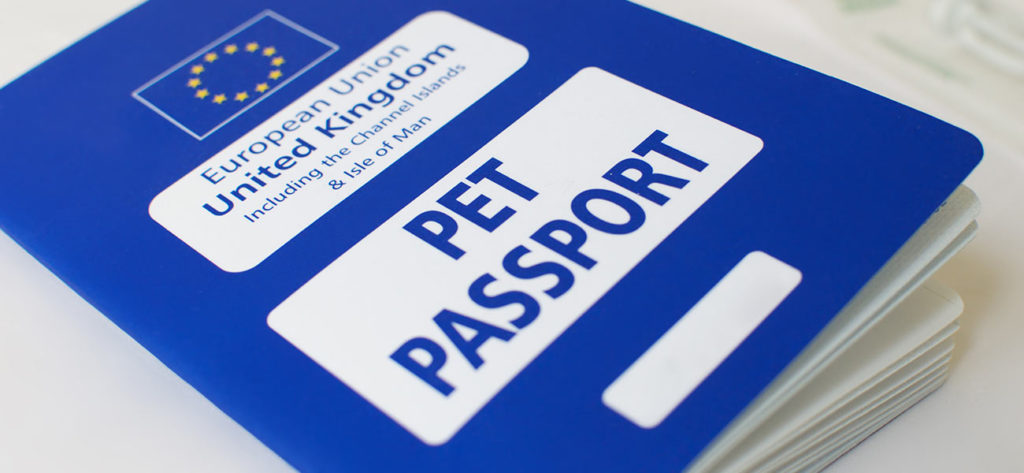
Currently if travelling abroad within the EU, your dog can have a pet passport covering them for multiple trips (which is the EU equivalent of the third party vet health certificates required for travel outside the EU which has to be completed for every trip). However this is potentially going to be affected by Brexit, therefore this is currently very up in the air.
Returning/Travelling to the UK
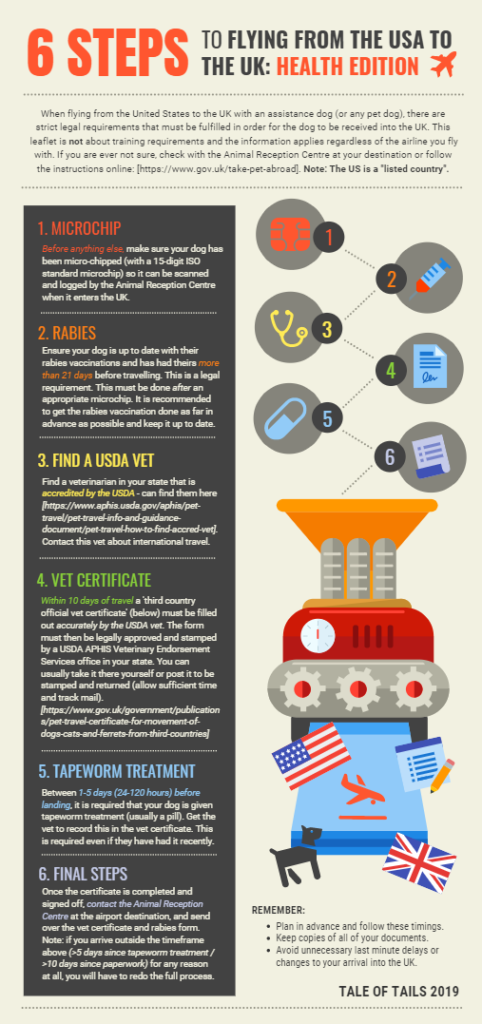
There is quite an in-depth and complex process involved when travelling to the UK from any country as we have fairly strict requirements in terms of paperwork needed for any pet to enter the UK (a lot stricter than the USA for example). This is necessary for any dog, however when travelling with an Assistance Dog you are likely to be doing it on your own (without a third party travel organisation sorting it out like there often is when your dog is travelling in cargo).
This link takes you to a resource (shown to the left) detailing the process of making sure the dog has all the health paperwork it needs. Dory Adelie has created this from her repeated experience of doing this process and it has some top tips. Note, it is specific to travelling from the USA (considered a “listed” country) to the UK, and while this does apply to a lot of other countries as well, it is important to check whether the country you are travelling to/from is a “listed” country or not as this affects what is required.
TRAINING/AIRLINE REQUIREMENTS
General Info
These requirements are in place for most airlines:
- Dog must be sufficiently trained to mitigate the individual’s disability
- Dog must remain with the individual and be kept under their control
- Dog must fit in the space of one seat and must not obstruct the aisles, otherwise an additional seat may need to be purchased (some airlines have a weight limit for dogs for one seat e.g. United Airlines has 65lbs)
- Dog must be sufficiently toilet trained
- Dog must be well-kept and clean
- Dog must be well-behaved with no aggression or unhygienic behaviour
Airlines generally do their best to accommodate you and your assistance dog – call them up and speak to their accessibility/special assistance team to find out what they can do. They often move you to bulkhead seating (as long as it is not an exit row) or leave a courtesy space next to you (if it is a quiet flight).
We recommend that you contact the accessibility service at the airline you are flying with in advance of booking tickets if it is not clear on the website, so you can be certain of their most up to date policies and also so they have a log of you getting in contact and nothing will get missed. If you are ever not sure of anything along the process, phone them so you can speak to the correct people (or get someone to do it for you) and then email to follow up so there is no confusion.
UK-Based Airlines (e.g. British Airways)
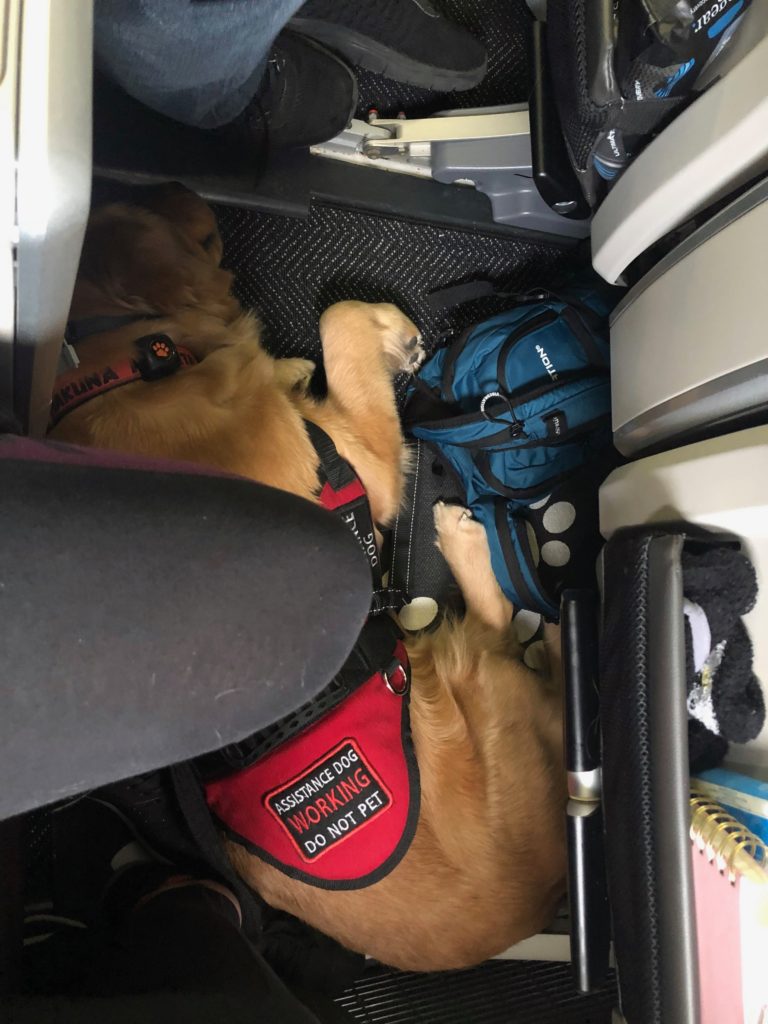
These generally follow the rule where Assistance Dogs International (ADI) accredited assistance dogs are entitled to fly, with proof of ADI accreditation from the organisation, proof of training and the health paperwork. For this reason, travelling with UK-based airlines can be problematic for owner trained assistance dog teams and those who are with other organisations. In the past they have requested that all contact was through the Animal Reception Centre (at Heathrow and Gatwick) and they put their requirements in place. However they are beginning to work on a case by case basis for those who do not have dogs trained by ADI accredited organisations, and handle it as an accessibility team not passing you onto the ARC (a vast improvement). They may allow you to travel, provided you can give proof of training and the qualifications of the trainers, as well as detailing the tasks that the dog does for you. As recent as August 2019, this was requested by British Airways, and while it can feel intrusive and many people would understandably not feel comfortable answering these questions, sometimes flying with UK-based airlines is the only option.
US-Based Airlines (e.g. American, United, Delta)
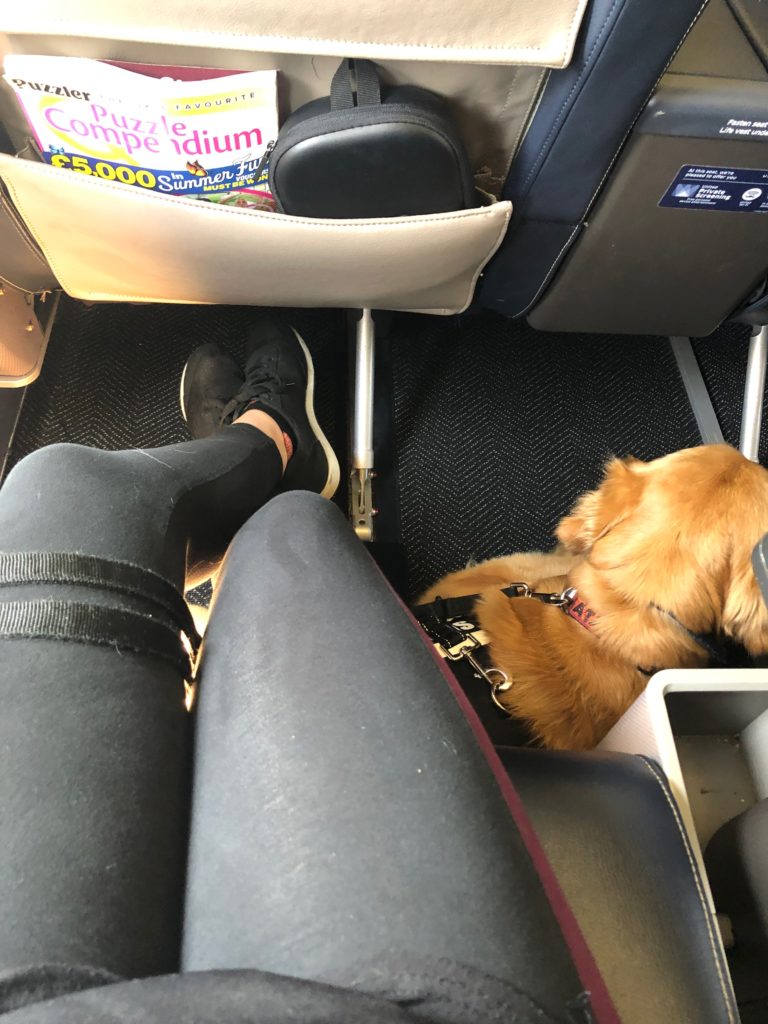
These airlines generally have a different policy and, aside from generally referring to them as “service dogs” (the American term for assistance dogs), it generally works better for those who are owner training their dog or who are with non-ADI organisations. What they require from you specifically can vary, but many times they just require confirmation that the dog is a trained assistance/service dog, what type (medical vs psychiatric) and that you have/will have all of the correct health paperwork. Note: As is stands, purely Psychiatric Assistance Dogs require a letter from your doctor, confirming the need for them. Unfortunately, when it comes to airlines, Psychiatric Assistance/Service dogs are currently grouped with Emotional Support Animals rather than other Service Dogs. Also, most of these airlines require that the dog is minimum 4 months and sufficiently toilet trained, and there are some limits for long flights (e.g. UK to US).
**further reading**
Our blog post: to find out more about travelling with an assistance dog by plane – including essentials to bring, top tips for travel from a frequent flyer and how to navigate airports with an AD.


